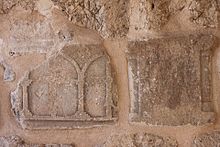Obruk Hanı
Coordinates: 38 ° 10 ′ 30 ″ N , 33 ° 10 ′ 59 ″ E
The Obruk Hanı , named after the Riesendoline (Turkish Obruk ), which is located behind the Han, is a Seljuk caravanserai northeast of Konya in the same province in Anatolia . The original name is no longer known; What is certain, however, is that Mevlânâ referred to it as Obruk Hanı as early as 1250 .
location
The Obruk Hanı is located in the far northeast of Karatay County . It is located about 75 kilometers northeast of the city center of Konya and about 82 kilometers west of Aksaray , four kilometers north of the national road 300 from Konya to Aksaray, south of the village of Obruk . When it was built, it was on the important trade route from Konya to Kayseri . Obruk Hanı can only be viewed from the outside, the interior is cordoned off due to the danger of art thieves.
Next to the Han there is an old Ottoman cemetery that is no longer used.
history
The construction date of Hans is not known. It is estimated that it was built between 1220 and 1250, as Obruk Hanı is between Saddedin Hanı (built in 1236) and Sultanhanı (built in 1229).
Obruk Hanı is mentioned in several historical sources, for example in the writings of Mevlânâ , who lived in Anatolia from 1227 to 1273. Pervâne Mu'in al-Din Suleyman , an adviser to the Seljuk Sultan Kılıç Arslan IV. (Died 1265), reports of fighting near the Obruk Hans. Records under Sultan Izz ad-Din Kai Kaus II from 1246 to 1256 report that Mongolian horsemen had captured Obruk Hanı. The building was badly damaged by several earthquakes, including the ceiling collapsing. In 1996 the University of Selçuk sighted the Han with the surrounding area and carried out excavations. A comprehensive renovation began in September 2007, during which the outer walls and the entrance portal were repaired. A destroyed southern part of the wall was rebuilt so that the Han can only be entered through the gate. Further renovation work is planned, but has not been carried out since 2009 (as of 2017).
architecture
The Han is a typical classic Seljuk symmetrical building, the entrance gate of which is oriented to the east-southeast. It consists of two interconnected structures: A square building with a side length of around 35 meters, with a central courtyard 20 meters long and 15 meters wide. To the right and left of the inner courtyard are five side halls, each about ten meters wide. For the most part, only the arches of the side halls have been preserved. The fact that the inner courtyard is larger than the enclosed area on the sides is typical of a Seljuq Han.
The so-called “winter hall” is attached to the west side and was used as accommodation, especially in the cold months. This hall is approximately 30 meters long and 20 meters wide. The cross vault , which has since collapsed, consisted of eight naves. These were three to four meters wide and nine meters long. In the middle there are feeding troughs for the animals. In the middle of the third aisle from the west was originally a small lantern tower, as known from Karatay Han ; however, it is completely destroyed. The wall to the inner courtyard with the portal has also collapsed.
The entry side is striking. In the center there is an inconspicuous, almost five meter high archway, which is supported on both sides by Byzantine columns with antique architraves . The typical Seljuk muqarna ornamentation is completely absent; this suggests that the han was built in a great hurry. The usual inscription above the archway is also missing. The archway itself was subsequently reduced by about one meter. The gate area has two storeys and is crowned by small battlements - unusual for a Seljuq Han. In the gate area on the second floor was a small mosque, which received light from the outside through three small square windows. In the gate building there are four more square rooms, two each to the right and left of the gate on the ground floor and on the first floor. It is probably a treasure chamber, in which the valuables of the caravans were stowed, as well as a sickroom and the accommodations for the guards.
The outer walls are almost completely preserved in the original. Ornaments on the outside are completely missing. The wall of the front building is reinforced by six support towers; in the winter hall, the walls of which are somewhat thinner, there are no external towers. The only openings to the outside are the portal and the three windows of the mosque.
art
In terms of its artistic features, this Han is unique. With one exception, Seljuk art motifs are completely absent: in the mosque above the gate there is a mihrāb (prayer niche), which, however, was badly damaged by art thieves. Instead, the appearance of the Hans is characterized by Byzantine components. The main aisle of the winter hall was supported by fourteen Byzantine columns, ten of which are still standing. The entrance portal also stands on antique columns. The inner courtyard was also originally decorated with columns. In the walls there are also numerous spoils (components from other, older buildings), some of which come from the ancient city of Perta in Lycaonia , others come from a Byzantine church and a monastery, which were located near Kizören . Most of the Spolia have Greek inscriptions and Christian symbols, but Latin inscriptions can also be found. However, numerous spoils were lost due to art thieves.
See also
Photo gallery
literature
- G. Schneider: Building ornaments of the Seljuks in Asia Minor; Wiesbaden, 1980
- Kurt Erdmann: The Anatolian Karavansaray of the 13th century; Berlin, 1961
Web links
Individual evidence
- ^ Kurt Erdmann: The Anatolian Karavansaray of the 13th century; Berlin, 1961











